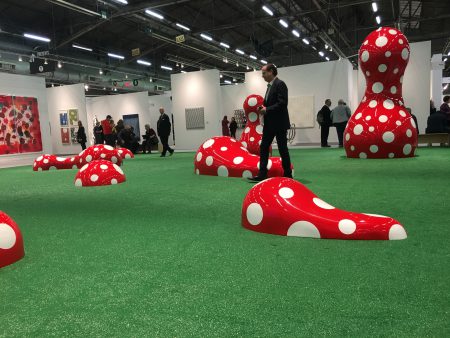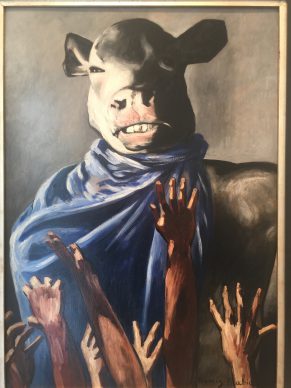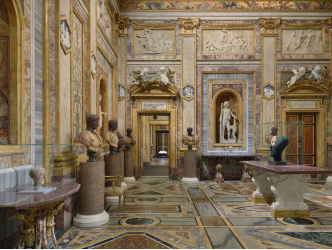Daft Punk
In electronic music, people often refer to a unique genre known as “French touch” which enjoyed great international success by liberating itself from its traditional musical heritage, and whose frontrunners were the now defunct Daft Punk. While the duo announced their separation on 22 February 2021, the idea of a “French touch” in the art trade seems to have become a reality.
New comers

This is firstly because Paris offers an extremely favourable setting – partly owing to the weakening of London’s appeal due to Brexit – and so numerous influential galleries are basing themselves in the French capital (White Cube, Levy-Gorvy, Zwirner, Massimo de Carlo, Continua, Mayoral Read the report about it here and here) or opening new premises there (Perrotin, Almine Rech, Kamel Mennour. Read the report about Kamel Mennour new space here).
French style of art commerce
It’s also due to the fact that there’s a French style of art commerce that really likes to mix recognized art or older names with recent creations.
Fiac was late
And yet up until now the Fiac, emblematic of the French art trade and banned from being held in real life like all large gatherings around the world, has been delayed in its move online, unlike its Swiss or British rivals who were quicker to adapt. Now it’s finally caught up: the Fiac is launching its own version of the OVR (online viewing room).
Limited time frame
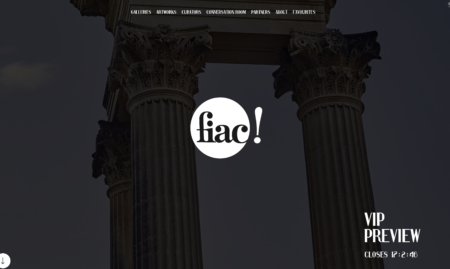
The operation, contrary to what we have seen elsewhere, is taking place over a very limited time frame and is only accessible to the general public from 4 to 7 March, with two earlier days reserved for VIPs. This online offering is much larger than the real-life Fiac, with 210 galleries from 28 countries each presenting five or ten artworks. We recall the fact that the great revolution of these online fairs is that the artworks’ prices or price bands are advertised to the virtual visitor.
Jennifer Flay
In terms of the rest, this new-generation Fiac offers a classic presentation. To access it, you have to share your details and this small change, as the director of the event Jennifer Flay explains, relates to a section that is visible on the home page called “Rencontres fortuites” (Chance Encounters). “This is where you can find work selected randomly from the 2000-odd pieces presented. No other site is offering this feature,” she observes. This is because the problem with these OVRs, compared to an in-person event where aesthetic surprises can be found at the bend of a walkway, is that people have a tendency to look for galleries and artists that are already familiar to them.
Guest curators
Jennifer Flay also points out that one way of making discoveries would be to look at the selections of guest curators like Bernard Blistène, director of the Musée National d’Art Moderne, or in an entirely different genre X Zhu-Nowell, assistant curator at the Guggenheim in New York.
Emmanuel Perrotin
The market’s “French touch” is present, for example, in the Parisian gallerist Emmanuel Perrotin who has branched out with spaces in New York, Tokyo, Hong Kong, Seoul and Shanghai. According to him, the online fairs aren’t always effective in terms of business volumes. However, he specifies an important factor: “a fair is an occasion for a gallery to display works before the event even takes place, to create a sense of urgency. We routinely send out the list of works before the OVR and as a result a number of pieces will already no longer be on the site when it opens.”
Alain Jacquet
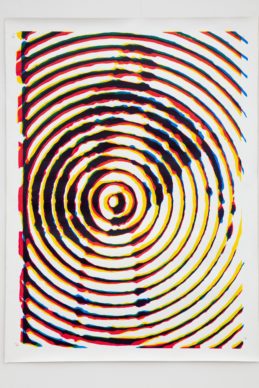
Alain Jacquet
Coinciding with the Fiac online, Emmanuel Perrotin announces that he is representing Alain Jacquet (1939-2008), one of the highly talented French Pop artists who has long been overlooked by the market. On the Fiac’s website he is exhibiting, for example, one of his silkscreen prints created in 1966, reissued in 2004, depicting a “Bat Girl” figure at the centre of a psychedelic target, on sale for between 25,000 and 50,000 euros (an unusually wide price band).
Hervé Loevenbruck
The other big discovery in a genre that is just as psychedelic can be found at the virtual booth of the Parisian Hervé Loevenbruck. For the past few years the Loevenbruck gallery has been championing artists who have been underappreciated in the past, such as the sculptor of Polish origin Alina Szapocznikow (1926-1973), who became a superstar of the market. This time he is unveiling, among others, the paintings of Frédéric Pardo (1944-2005), a high-flying Parisian dandy who wasn’t shy of using hallucinogenic substances, after which he used to paint complex and fantastical compositions in bright colours. His portrait of the Buddhist wise man Milarepa, dating from 1966, is on sale for 65,000 euros.
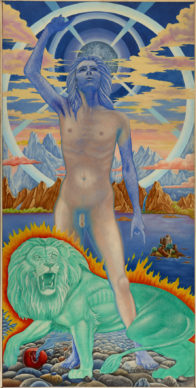
Frédéric Pardo
Almine Rech
The French dealer Almine Rech, who has an array of galleries in Paris, New York, Brussels, London and Shanghai, emphasizes the fact that her business is particularly booming right now in the United States and in China because collectors are hungry for works that encapsulate the zeitgeist. At the Fiac OVR she is presenting, among other things, a canvas by an artist who, according to her, has made pioneering work that is highly influential today, Kenny Scharf (born in 1958).
Kenny Scharf
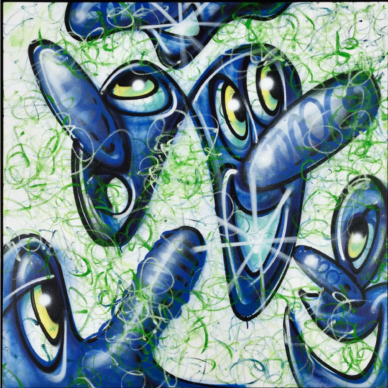
Kenny Scharf
The artist, who used to live in New York with Keith Haring and shared a great friendship with Jean-Michel Basquiat, is one of the founding members of the New York street art scene. According to Almine Rech his prices have increased by 20% in five years and his paintings are now bought by major collections in England and the United States. A canvas from 2021, a picture of the cosmos animated by cartoonish figures, is on sale for between 50,000 and 75,000 euros.
Christian Berst
This is the first time that the Parisian Christian Berst, representing another kind of “French touch”, is participating in the Fiac. His gallery was founded in 2005 and seeks out artists from around the world that Jean Dubuffet would have categorized as “Art brut”: who generally have not received an artistic education and according to the gallerist “display a certain mental and social alterity”. A growing audience is interested in these kinds of creations, which avoid all attempts to be attractive.

Misleidys Castillo Pedroso
(born in 1985) for example, an autistic Cuban artist, obsessively creates giant cut-out bodybuilding figures, who always exhibit an anomaly (on sale for 11,000 euros).
Robbie Fitzpatrick
The Californian Robbie Fitzpatrick, who has been based in Paris for the past 3 years, does not currently have a dedicated space. This headhunter for young artists who are most often American chose the French capital as a promotional platform where he stages pop-ups. This is the new generation of the international “French touch”.
Chino Amobi
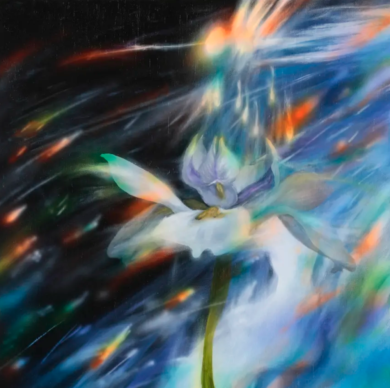
Chino Amobi
At the virtual Fiac he’s presenting Chino Amobi (born in 1984) from Richmond, Virginia, who was first known as an electronic musician. But when Chino is wearing his painting hat, he makes still lifes against abstract backgrounds. The context could suit the psychedelic setting of the dancefloor, while the exotic flowers depicted could be metaphors for musicians or dancers who have come from elsewhere (on sale for 4,500 euros). His works have already been exhibited at the Luma Foundation in Zurich.
Olivier Antoine
Lastly, Olivier Antoine from the Art Concept gallery is known as a French discoverer of international talents. Since 2007 he has been promoting the German artist who is based in France, Ulla von Brandenburg (born in 1974), who was the subject of an exhibition at the Palais de Tokyo before its closure due to Covid. Her works, paintings, and installations address the theatrical, with all that entails in terms of accessories of drama and bombast. She has made a 23-minute film issued in five copies about a community that puts on a play (on sale for 45,000 euros).
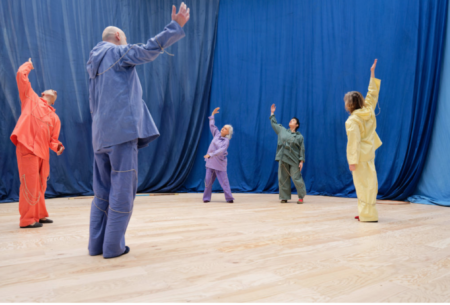
Ulla von Brandenburg
Not yet an experience
Olivier Antoine believes, however, that the Fiac OVR operation doesn’t yet have all the assets to be a creative offering. “Virtual spaces are there to attract new art fans on the condition that what’s presented is a real experience. The Fiac is not there yet.”
It’s clear that the models for virtual fairs that have emerged, propelled by the public health crisis, are still only in their infancy. A time will come when they will be true journeys through the artistic landscape of the 21st century. This is a time that we impatiently await.
Donating=Supporting

Support independent news on art.
Your contribution : Make a monthly commitment to support JB Reports or a one off contribution as and when you feel like it. Choose the option that suits you best.
Need to cancel a recurring donation? Please go here.
The donation is considered to be a subscription for a fee set by the donor and for a duration also set by the donor.

